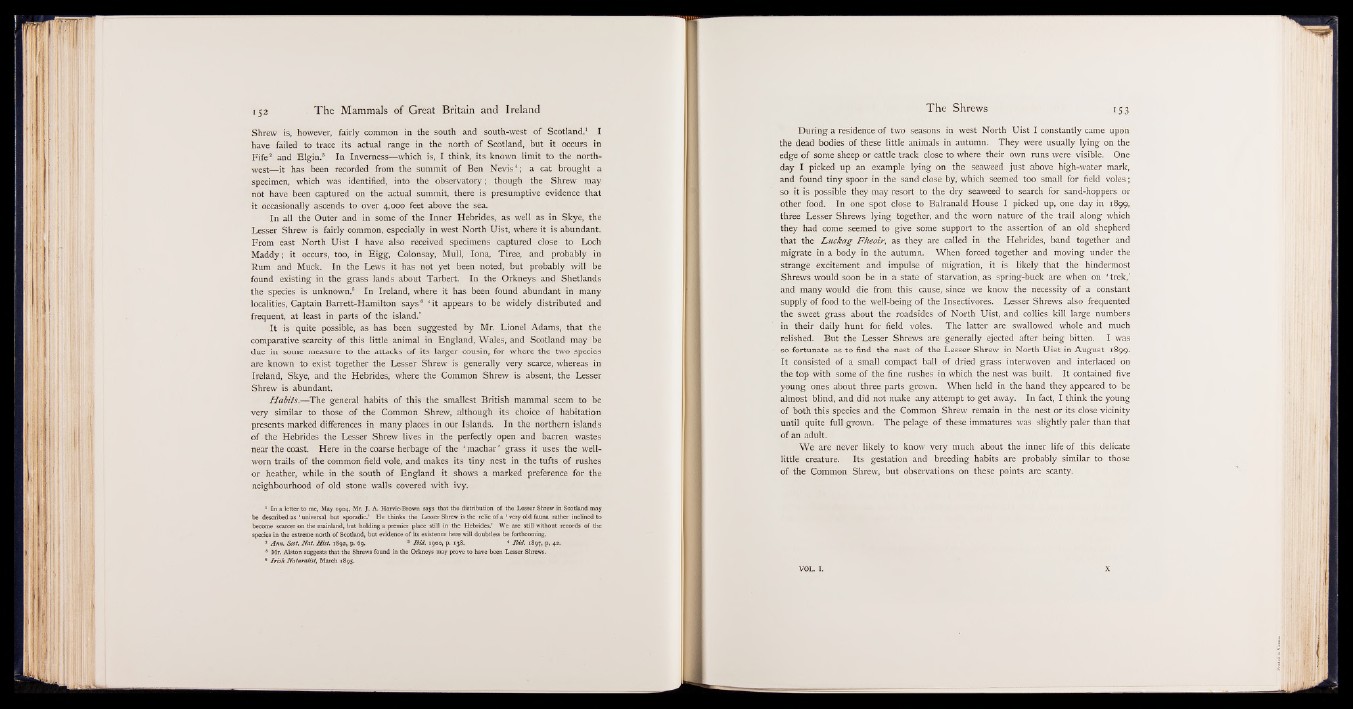
Shrew is, however, fairly common in the south and south-west of Scotland.1 I
have failed to trace its actual range in the north of Scotland, but it occurs in
Fife2 and Elgin.® In Inverness— which is, I think, its known limit to the northwest—
it has been recorded from the summit of Ben Nevis4; a cat brought a
specimen, which was identified, into the observatory; though the Shrew may
not have been captured on the actual summit, there is presumptive evidence that
it occasionally ascends to over 4,000 feet above the sea.
In all the Outer and in some of the Inner Hebrides, as well as in Skye, the
Lesser Shrew is fairly common, especially in west North Uist, where it is abundant.
From east North Uist I have also received specimens captured close to Loch
Maddy; it occurs, too, in Eigg, Colonsay, Mull, Iona, Tiree, and probably in
Rum and Muck. In the Lews it has not yet been noted, but probably will be
found existing in the grass lands about Tarbert. In the Orkneys and Shetlands
the species is unknown.6 In Ireland, where it has been found abundant in many
localities, Captain Barrett-Hamilton says6 ‘ it appears to be widely distributed and
frequent, at least in parts of the island.’
It is quite possible, as has been suggested by Mr. Lionel Adams, that the
comparative scarcity of this little animal in England, Wales, and Scotland may be
due in some measure to the attacks of its larger cousin, for where the two species
are known to exist together the Lesser Shrew is generally very scarce, whereas in
Ireland, Skye, and the Hebrides, where the Common Shrew is absent, the Lesser
Shrew is abundant.
Habits.— The general habits of this the smallest British mammal seem to be
very similar to those of the Common Shrew, although its choice of habitation
presents marked differences in many places in our Islands. In the northern islands
of the Hebrides the Lesser Shrew lives in the perfectly open and barren wastes
near the coast. Here in the coarse herbage of the ‘ machar ’ grass it uses the well-
worn trails of the common field vole, and makes its tiny nest in the tufts of rushes
or heather, while in the south of England it shows a marked preference for the
neighbourhood of old stone walls covered with ivy.
1 In a letter to me, May 1904, Mr. J. A. Harvie-Brown says that the distribution of the Lesser Shrew in Scotland may
be described as ‘ universal but sporadic.’ He thinks the Lesser Shrew is the relic of a ‘ very old fauna rather inclined to
become scarcer on the mainland, but holding a premier place still in the Hebrides.’ We are still without records of the
species in the extreme north o f Scotland, but evidence of its existence here will doubtless be forthcoming.
* Ann. Scot. Nat. H ist. 1892, p. 69. 8 Ibid. 1900, p. 138. 4 Ibid. 1897, p, 42.
8 Mr. Alston suggests that the Shrews found in the Orkneys may prove to have been Lesser Shrews.
8 Irish Naturalist, March 1895.
During a residence of two seasons in west North Uist I constantly came upon
the dead bodies of these little animals in autumn. They were usually lying on the
edge of some sheep or cattle track close to where their own runs were visible. One
day I picked up an example lying on the seaweed just above high-water mark,
and found tiny spoor in the sand close by, which seemed too small for field voles;
so it is possible they may resort to the dry seaweed to search for sand-hoppers or
other food. In one spot close to Balranald House I picked up, one day in 1899,
three Lesser Shrews lying together, and the worn nature of the trail along which
they had come seemed to give some support to the assertion of an old shepherd
that the Luckag Fheoir, as they are called in the Hebrides, band together and
migrate in a body in the autumn. When forced together and moving under the
strange excitement and impulse of migration, it is likely that the hindermost
Shrews would soon be in a state of starvation, as spring-buck are when on ‘ trek,’
and many would die from this cause, since we know the necessity of a constant
supply of food to the well-being of the Insectivores. Lesser Shrews also frequented
the sweet grass about the roadsides of North Uist, and collies kill large numbers
in their daily hunt for field voles. The latter are swallowed whole and much
relished. But the Lesser Shrews are generally ejected after being bitten. I was
so fortunate as to find the nest of the Lesser Shrew in North Uist in August 1899.
It consisted of a small compact ball of dried grass interwoven and interlaced on
the top with some of the fine rushes in which the nest was built. It contained five
young ones about three parts grown. When held in the hand they appeared to be
almost blind, and did not make any attempt to get away. In fact, I think the young
of both this species and the Common Shrew remain in the nest or its close vicinity
until quite full grown. The pelage of these immatures was slightly paler than that
of an adult.
We are never likely to know very much about the inner life of this delicate
little creature. Its gestation and breeding habits are probably similar to those
of the Common Shrew, but observations on these points are scanty.